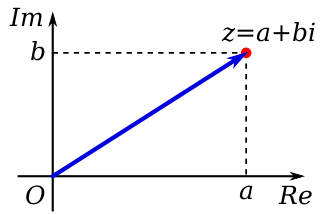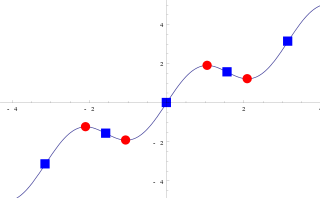
In mathematics, a complex number is an element of a number system that extends the real numbers with a specific element denoted i, called the imaginary unit and satisfying the equation ; every complex number can be expressed in the form , where a and b are real numbers. Because no real number satisfies the above equation, i was called an imaginary number by René Descartes. For the complex number , a is called the real part, and b is called the imaginary part. The set of complex numbers is denoted by either of the symbols or C. Despite the historical nomenclature "imaginary", complex numbers are regarded in the mathematical sciences as just as "real" as the real numbers and are fundamental in many aspects of the scientific description of the natural world.
In mathematics, a polynomial is an expression consisting of indeterminates and coefficients, that involves only the operations of addition, subtraction, multiplication, and positive-integer powers of variables. An example of a polynomial of a single indeterminate x is x2 − 4x + 7. An example with three indeterminates is x3 + 2xyz2 − yz + 1.
In algebra, the rational root theorem states a constraint on rational solutions of a polynomial equation

In geometry, the tangent line (or simply tangent) to a plane curve at a given point is the straight line that "just touches" the curve at that point. Leibniz defined it as the line through a pair of infinitely close points on the curve. More precisely, a straight line is said to be a tangent of a curve y = f(x) at a point x = c if the line passes through the point (c, f(c)) on the curve and has slope f'(c), where f' is the derivative of f. A similar definition applies to space curves and curves in n-dimensional Euclidean space.
A finite difference is a mathematical expression of the form f (x + b) − f (x + a). If a finite difference is divided by b − a, one gets a difference quotient. The approximation of derivatives by finite differences plays a central role in finite difference methods for the numerical solution of differential equations, especially boundary value problems.

In mathematics, differential calculus is a subfield of calculus that studies the rates at which quantities change. It is one of the two traditional divisions of calculus, the other being integral calculus—the study of the area beneath a curve.
The fundamental theorem of algebra, also known as d'Alembert's theorem, or the d'Alembert–Gauss theorem, states that every non-constant single-variable polynomial with complex coefficients has at least one complex root. This includes polynomials with real coefficients, since every real number is a complex number with its imaginary part equal to zero.
Bézout's theorem is a statement in algebraic geometry concerning the number of common zeros of n polynomials in n indeterminates. In its original form the theorem states that in general the number of common zeros equals the product of the degrees of the polynomials. It is named after Étienne Bézout.

La Géométrie was published in 1637 as an appendix to Discours de la méthode, written by René Descartes. In the Discourse, he presents his method for obtaining clarity on any subject. La Géométrie and two other appendices, also by Descartes, La Dioptrique (Optics) and Les Météores (Meteorology), were published with the Discourse to give examples of the kinds of successes he had achieved following his method.
In mathematics, a linear differential equation is a differential equation that is defined by a linear polynomial in the unknown function and its derivatives, that is an equation of the form

In mathematics, Vieta's formulas relate the coefficients of a polynomial to sums and products of its roots. They are named after François Viète.
In mathematics, an algebraic function is a function that can be defined as the root of a polynomial equation. Quite often algebraic functions are algebraic expressions using a finite number of terms, involving only the algebraic operations addition, subtraction, multiplication, division, and raising to a fractional power. Examples of such functions are:

Critical point is a wide term used in many branches of mathematics.
In mathematics, Descartes' rule of signs, first described by René Descartes in his work La Géométrie, is a technique for getting information on the number of positive real roots of a polynomial. It asserts that the number of positive roots is at most the number of sign changes in the sequence of polynomial's coefficients, and that the difference between these two numbers is always even. This implies, in particular, that if the number of sign changes is zero or one, then there are exactly zero or one positive roots, respectively.
In mathematics, the splitting circle method is a numerical algorithm for the numerical factorization of a polynomial and, ultimately, for finding its complex roots. It was introduced by Arnold Schönhage in his 1982 paper The fundamental theorem of algebra in terms of computational complexity. A revised algorithm was presented by Victor Pan in 1998. An implementation was provided by Xavier Gourdon in 1996 for the Magma and PARI/GP computer algebra systems.
In mathematics, the formal derivative is an operation on elements of a polynomial ring or a ring of formal power series that mimics the form of the derivative from calculus. Though they appear similar, the algebraic advantage of a formal derivative is that it does not rely on the notion of a limit, which is in general impossible to define for a ring. Many of the properties of the derivative are true of the formal derivative, but some, especially those that make numerical statements, are not.

A timeline of calculus and mathematical analysis.
In mathematics, Budan's theorem is a theorem for bounding the number of real roots of a polynomial in an interval, and computing the parity of this number. It was published in 1807 by François Budan de Boislaurent.
In mathematics, and, more specifically in numerical analysis and computer algebra, real-root isolation of a polynomial consist of producing disjoint intervals of the real line, which contain each one real root of the polynomial, and, together, contain all the real roots of the polynomial.

Most of the terms listed in Wikipedia glossaries are already defined and explained within Wikipedia itself. However, glossaries like this one are useful for looking up, comparing and reviewing large numbers of terms together. You can help enhance this page by adding new terms or writing definitions for existing ones.











